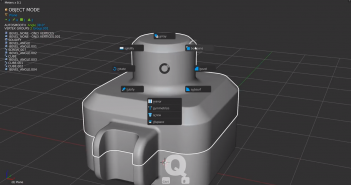
Anisotropic filtering better eliminates directional artefacts when viewing textures from oblique viewing angles. In the event of a texture coordinate being outside the texture, it is either clamped or wrapped. The cheapest method is to use the nearest-neighbour interpolation, but bilinear interpolation or trilinear interpolation between mipmaps are two commonly used alternatives which reduce aliasing or jaggies. when viewed as pixels on the screen) are calculated from the texels (texture pixels) is governed by texture filtering. Bump mapping has become popular in recent video games, as graphics hardware has become powerful enough to accommodate it in real-time. Another multitexture technique is bump mapping, which allows a texture to directly control the facing direction of a surface for the purposes of its lighting calculations it can give a very good appearance of a complex surface (such as tree bark or rough concrete) that takes on lighting detail in addition to the usual detailed coloring. Modern graphics may use more than 10 layers, which are combined using shaders, for greater fidelity. Microtextures or detail textures are used to add higher frequency details, and dirt maps may add weathering and variation this can greatly reduce the apparent periodicity of repeating textures. For instance, a light map texture may be used to light a surface as an alternative to recalculating that lighting every time the surface is rendered. Multitexturing is the use of more than one texture at a time on a polygon. Some rendering techniques such as subsurface scattering may be performed approximately by texture-space operations.
#MATERIALIZE TEXTURE MANUAL#
UV unwrapping tools typically provide a view in texture space for manual editing of texture coordinates. Texture mapping maps the model surface (or screen space during rasterization) into texture space in this space, the texture map is visible in its undistorted form. Textures may be repeated or mirrored to extend a finite rectangular bitmap over a larger area, or they may have a one-to-one unique " injective" mapping from every piece of a surface (which is important for render mapping and light mapping, also known as baking). These coordinates are interpolated across the faces of polygons to sample the texture map during rendering. More complex mappings may consider the distance along a surface to minimize distortion. This might be accomplished via planar projection or, alternatively, cylindrical or spherical mapping. It is also possible to associate a procedural transformation from 3d space to texture space with the material. This may be done through explicit assignment of vertex attributes, manually edited in a 3D modelling package through UV unwrapping tools.

Every vertex in a polygon is assigned a texture coordinate (which in the 2d case is also known as UV coordinates). This process is akin to applying patterned paper to a plain white box.
#MATERIALIZE TEXTURE SOFTWARE#
Texture maps may be acquired by scanning/ digital photography, designed in image manipulation software such as GIMP, Photoshop, or painted onto 3D surfaces directly in a 3D paint tool such as Mudbox or zbrush. Modern hardware often supports cube map textures with multiple faces for environment mapping. (They may be considered a modern evolution of tile map graphics).


Multiple texture images may be combined in texture atlases or array textures to reduce state changes for modern hardware. Multiple texture maps (or channels) may be combined for control over specularity, normals, displacement, or subsurface scattering e.g. It is possible to use the alpha channel (which may be convenient to store in formats parsed by hardware) for other uses such as specularity. They usually contain RGB color data (either stored as direct color, compressed formats, or indexed color), and sometimes an additional channel for alpha blending ( RGBA) especially for billboards and decal overlay textures.

Rendering APIs typically manage texture map resources (which may be located in device memory) as buffers or surfaces, and may allow ' render to texture' for additional effects such as post processing or environment mapping. For use with modern hardware, texture map data may be stored in swizzled or tiled orderings to improve cache coherency. They may have 1-3 dimensions, although 2 dimensions are most common for visible surfaces. They may be stored in common image file formats, referenced by 3d model formats or material definitions, and assembled into resource bundles. This may be a bitmap image or a procedural texture. 3.Ī texture map is an image applied (mapped) to the surface of a shape or polygon. For the album by Steve Roach, see Texture Maps: The Lost Pieces Vol.


 0 kommentar(er)
0 kommentar(er)
